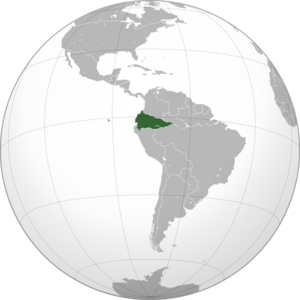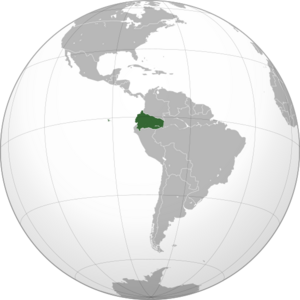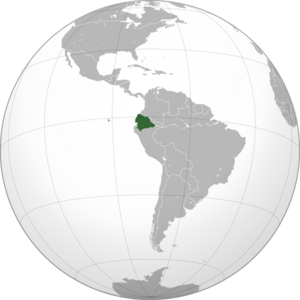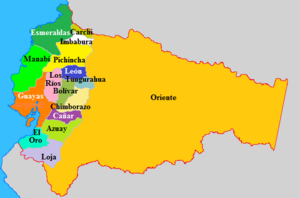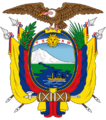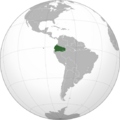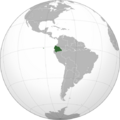History of Ecuador (1895–1925) facts for kids
Quick facts for kids
Republic of Ecuador
República del Ecuador
|
|||||||||
|---|---|---|---|---|---|---|---|---|---|
| 1895–1925 | |||||||||
|
|
|||||||||
|
Motto: "Dios, patria y libertad"
|
|||||||||
|
Anthem: Salve, Oh Patria
|
|||||||||
| Capital | Quito | ||||||||
| Government | Liberal presidential republic | ||||||||
| President | |||||||||
|
• 1895–1901
|
Eloy Alfaro | ||||||||
|
• 1901–1905
|
Leónidas Plaza | ||||||||
|
• 1905–1906
|
Lizardo García | ||||||||
| Vice President | |||||||||
|
• See list
|
See list (from Manuel Benigno Cueva to Alfredo Baquerizo) | ||||||||
| Legislature | National Congress | ||||||||
| History | |||||||||
|
• Established
|
5 June 1895 | ||||||||
|
• Disestablished
|
9 July 1925 | ||||||||
|
|||||||||
| Today part of | Ecuador Colombia Peru |
||||||||
This article tells the story of Ecuador from 1895 to 1925. This time was very important for the country. It was when the Liberal Party gained a lot of power. Their main leader was Eloy Alfaro. He was a bit like Gabriel García Moreno for the Conservative Party, but on the opposite side.
Alfaro's ideas were revolutionary for Ecuador. He worked to reduce the power and special rights that the Roman Catholic Church had. Before him, the Church had a lot of influence in the government. This change caused a lot of conflict. During Alfaro's first year as president, there was a civil war. Church leaders encouraged people to fight against Alfaro's government. Some were also hurt by Alfaro's supporters. Important Church leaders like Bishop Pedro Schumacher and Bishop Arsenio Andrade led the early resistance. Luckily, a wise Archbishop named Federico González Suárez helped calm things down. He asked the clergy to stop getting involved in politics.
Contents
Ecuador's Liberal Era (1895-1925)
The Liberal government made some important changes, but not many huge ones. They started to regulate the system where people had to work to pay off debts, especially in the mountains. This system, called debt peonage, was finally outlawed in 1918. This meant people could no longer be put in jail just for owing money.
However, these small improvements for Native Ecuadorians and the mixed-race working class (called montuvio) were overshadowed. The world economy faced big problems, and the government strongly repressed new labor movements in the early 1920s. Also, Liberal rule did not lead to a very stable democracy. In fact, the first half of this period saw more illegal takeovers of power and military-led governments than before.
Challenges to Liberal Leadership
A big reason for the instability was that the Liberal Party itself was not united. Eloy Alfaro and another strong military leader, General Leónidas Plaza Gutiérrez, were rivals for nearly two decades. After Alfaro's first time as president, Plaza was elected and served from 1901 to 1905.
In 1906, after someone close to Plaza was elected, Alfaro staged a coup d'état (a sudden takeover of the government). He became president again. But in 1911, Alfaro was overthrown himself. This happened after he refused to give power to Emilio Estrada, who he had chosen to be his successor.
The Rivalry Between Alfaro and Plaza
Four months later, Estrada died suddenly. This led to a short civil war, which was the peak of the rivalry between Alfaro and Plaza. Alfaro returned from Panama to lead a military group in Guayaquil. They challenged the temporary government in Quito, which was led by General Plaza.
Alfaro's rebellion was quickly defeated. He was captured and taken to Quito by the very railroad he had worked so hard to build. In the capital, Alfaro and some of his friends were sadly killed by a mob. Uprisings by his supporters, like the Concha Revolution, were also stopped.
The Rule of "La Argolla"
Soon after, Plaza began his second term as president. This was the first of four legal changes in government. After Plaza (1912–16) came Alfredo Baquerizo Moreno (1916–20), then José Luis Tamayo (1920–24), and Gonzalo Córdova (1924–25).
During the second half of Liberal rule, the real power was not with the government. It was held by a group of wealthy coastal farmers and bankers. This group was known as la argolla (meaning "the ring"). Their most important member was the Commercial and Agricultural Bank of Guayaquil, led by Francisco Urbina Jado.
This bank became very powerful by lending huge amounts of money to the government and to private people. According to historian Oscar Efren Reyes, the bank was so influential that even candidates for president and their ministers, senators, and deputies needed the bank's approval first. Many private loans went to members of the Association of Agriculturists of Ecuador. This group also received government money meant to help cacao growers, but they often used it for themselves.
Economic Problems and Social Unrest
Everyone involved in la argolla – from government officials to bankers and farmers – said they were Liberals. But their financial actions hurt not only the Liberal Party but also the country's economy. The private banks printed too much money, which caused high inflation.
Ecuador's economic problems in the early 1920s were also caused by things outside the politicians' control. A fungal disease damaged Ecuador's cacao trees. Also, new competition from British colonies in Africa ended Ecuador's long success in exporting cacao. What was left of the cacao industry suffered even more when world demand dropped sharply during the Great Depression.
The economic crisis hit the working class and the poor especially hard. Their wages could not keep up with inflation. In response, workers held a general strike in Guayaquil in 1922. The next year, there was a peasant rebellion in the central mountains. Both actions aimed to improve wages and working conditions. Both were ended with major massacres.
President Gonzalo Córdova, who was closely linked to la argolla, had won his election unfairly. People were unhappy, the economy was bad, and the president was sick. All these things led to a peaceful takeover of the government in July 1925.
Unlike earlier military takeovers in Ecuador, the 1925 coup was not led by a single powerful leader (a caudillo). Instead, it was done by a group called the League of Young Officers. They came to power with a plan to make many social changes. They wanted to end the old Liberal-Conservative debates and stop the rule of the Liberals, who had been in power for thirty years and were seen as corrupt.
Images for kids




